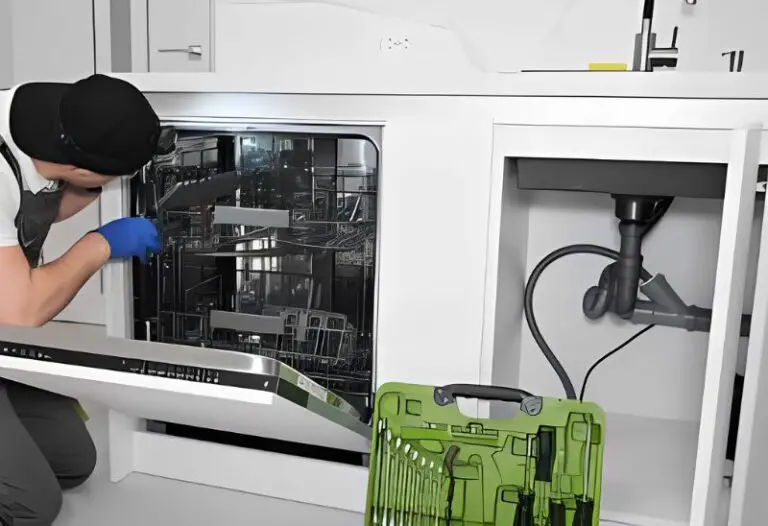Dishwashers are a staple in modern-day kitchens, tirelessly cleaning our dishes with efficiency. Did you know that some dishwashers have motors that can reverse direction? This feature isn’t just for show; it serves a functional purpose.
By changing the rotation direction of the spray arms inside the dishwasher, it alters the water flow and trajectory. This clever adjustment ensures that water reaches all your dishes, dislodging food particles and grime more effectively for a thorough clean.
Key Takeaways
- Some dishwashers reverse motor rotation to improve cleaning efficiency.
- The reversal is achieved by changing the motor’s wiring configuration.
- This feature helps distribute water evenly, preventing food from settling.

How Reversing Motors Work
Have you ever wondered what makes your dishwasher so good at cleaning every angle of your dishes? It’s all thanks to a little bit of engineering magic called a reversing motor.
Single Direction vs. Reversing Motors:
- Single Direction Motors: These motors spin the impeller in one direction only, which means water sprays out in a fixed pattern.
- Reversing Motors: On the flip side, reversing motors can change the direction they spin. This can switch up the water flow and get to more of those hard-to-reach spots on your dishes.
The Science of Spin:
- Motor Rotation: Inside the dishwasher, the motor powers an impeller that moves the water. When the motor reverses, so does the impeller.
- Magnetic Field: The motor uses a magnetic field to push and pull on magnets around a rotor, which creates rotation.
- Polarity: By flipping the polarity, or the direction of the electrical current, the magnetic field changes direction and with it, the motor’s rotation.
By changing direction, the water jets hit your dishes at different angles, which is more effective at dislodging food and grime. Think of it like brushing your teeth from different angles to make sure you reach every spot.
Here’s what happens when a motor reverses:
- Electrical current’s polarity changes.
- Magnetic field’s direction flips.
- Motor’s rotation switches to the opposite direction.
- Water flow and pressure from the impeller are altered.
This mechanism doesn’t just make the cleaning process more thorough, but it also prevents wear and tear, as constantly pushing against the same spots can lead to damage over time.
Unveiling the Two-Way Spin: Reasons and Benefits
One little-known trick up the sleeve of some modern dishwashers is the ability to reverse the motor’s rotation. Here’s why this feature is a game-changer:
Enhanced Cleaning Power:
- Targeted Spraying: When the motor changes direction, so does the spray arm, and that means water can zigzag its way to reach those hard-to-get spots.
- Loosening Debris: Foods like cereal that cling on for dear life are more likely to be swept away as the spray swings back and forth.
- Reduced Wash Times: More effective spraying means less time needed to get your dishes sparkling, saving both time and energy.
Improved Efficiency and Performance:
- Pump Optimization: By flipping the direction now and then, the pump wears down more evenly, which can mean a happier, longer-lasting dishwasher.
- Reduced Noise: A quieter kitchen is a win for everyone, and the alternating motor rotation helps achieve just that.
- Energy Savings: Efficient cleaning often leads to less power used. Quick cycles can mean more savings on your energy bill.
Specific Wash Cycles:
- Pre-Rinse Cycle: The initial attack against the day’s grime might enlist reversals to knock off the big bits.
- Delicate Cycle: Your precious china gets a gentler touch with the softer motions coming from a back-and-forth rotation.
- Sanitizing Cycle: With back-and-forth movement, your dishwasher ensures that your dishes aren’t just clean, but they’re well sanitized, too.
Remember, not all manufacturers include this snazzy feature, so it’s something to look out for when you’re in the market for a new kitchen companion. This bi-directional motor magic could make your routine dish duty a breeze, with each cycle tailored to ensure your kitchenware comes out impeccably clean.
Delving Deeper: Exploring Different Dishwasher Motor Technologies
When you’re looking into dishwasher motor technologies, it’s fascinating to see how different types offer unique benefits.
Here’s a brief overview of the primary motor technologies used in dishwashers:
- AC Induction Motors: These are the go-to for many dishwashers.
- Simple and reliable: They operate by creating a rotating magnetic field.
- Limited direction control: To reverse its rotation, they need extra circuitry.
- DC Brushless Motors: If you’re after something quieter and more efficient, this is it.
- Pros: They save energy and reduce noise.
- Convenience: Reversing direction is a breeze thanks to sophisticated electronics.
- Inverter Motors: Now these are the cream of the crop in dishwasher motor tech.
- Top-notch tech: They give you full control over the motor’s speed and direction.
- Efficient cleaning: Expect optimized wash cycles that adapt the motor’s movements.
Let’s peek at how this tech is put to use:
- Brand X’s PowerWash+ Cycle: This smart feature reverses rotation to clean every tough spot on your dishes.
- Benefits: Yielding nothing but shiny and clean dishes.
- Brand Y’s EcoWash Mode: Here’s an example of inverter tech at its best.
- Eco-friendly: It cuts down on wash time and energy, helping both your wallet and the planet.
It’s really cool how these motor technologies can make such a big impact on your dishes’ cleanliness and the environment.
Each technology brings something special to the table, from easy and quiet operation to custom wash cycles tailored for energy conservation.
Tips for Choosing a Dishwasher with Motor Reversal
When selecting a dishwasher with a motor reversal feature, think about your personal cleaning needs.
Some models offer special cycles for heavily soiled pots and gentle washes for fine china. Models with motor reversal can enhance these cycles by changing the direction of the spray arms, ensuring a thorough clean.
Here’s how to find one that works best for you:
- Cleaning Priorities: Look at whether the dishwasher offers power washing or delicate wash options. Motor reversal helps these cycles to cover all angles and provides consistent results.
- Technology & Models: Strongly consider the type of motor technology and the efficiency of the spray arm movement. A good starting point is to compare models with a feature that alternates the motor’s rotation, promising better water coverage and improved cleaning.
If you’re into troubleshooting or dishwasher repair, understanding how the motor reversal impacts dishwasher operation might be handy for future reference.
While various options exist, here’s a quick checklist to keep you on track:
- Feature Must-Haves:
- Motor Reversal
- Variable cycle options
- Efficiency rating
- Performance:
- Look for low decibel levels (~40 dba) for quiet operation.
- Ensure the design includes features that aid in your specific cleaning routine.
Frequently Asked Questions
What might prevent a dishwasher from drying dishes adequately?
Your dishwasher might not dry dishes adequately if the vent fails to open or the heating element is malfunctioning. Ensure the rinse aid dispenser is working and filled because it helps with drying. Blocked vents or a faulty thermostat can also hinder the drying cycle.
How does the design of a dishwasher impeller affect its performance?
The impeller in your dishwasher forces water through the spray arms. A well-designed impeller can generate strong water flow, which optimizes the dishwasher’s ability to clean dishes effectively. If an impeller is damaged or poorly designed, the dishwasher’s performance may diminish.
What role does a diverter motor play in the operation of a dishwasher?
A diverter motor in a dishwasher directs water to different spray arms. This ensures that water is distributed evenly and reaches all dishes during a wash cycle. If your diverter motor isn’t functioning, you may find some dishes aren’t getting cleaned properly.
What signs indicate a dishwasher motor might be malfunctioning?
Signs of a malfunctioning dishwasher motor include unusual noises like grinding or squeaking during a cycle. Also, if the dishwasher isn’t cleaning properly or if it stops mid-cycle, the motor may be the issue. A technician can confirm motor problems and suggest solutions.
What are the typical issues that dishwashers encounter that lead to repairs?
Common dishwasher issues that necessitate repairs include water not draining, dishes remaining dirty after a cycle, leaks, unresponsive controls, and failure to start. Regular maintenance can often prevent these problems, but when they do occur, a professional might be needed.
Can you explain how a dishwasher motor operates to clean dishes?
The motor in your dishwasher is responsible for circulating water through the spray arms. When it rotates in different directions, it changes the water flow, which helps in dislodging food particles from your dishes. A properly functioning motor is key to a dishwasher’s performance.





